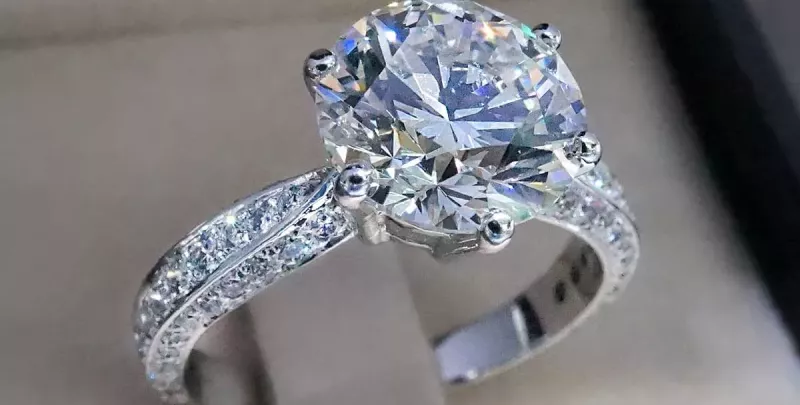Choosing the perfect diamond engagement ring is an important decision, one that requires careful consideration of various factors, this is one purchase, you’ll want to get right.
In the jewellery trade, the 4Cs - Carat weight, Cut, Colour, and Clarity, stand as the cornerstone of diamond evaluation. These four criteria not only determine a diamond's overall quality but also influence its price. In this comprehensive guide, we will delve into each of the 4Cs, providing insights and tips to help you make an informed choice when shopping for the symbol of your love.
Carat Weight: The Bold Statement
Carat weight is often the first characteristic people think of when it comes to diamonds. It's a measure of the diamond's size, but it's important to note that size isn't the only factor that defines a diamond's appeal. Carat weight is measured in metric carats, where one carat is equivalent to 0.2 grams.
When considering carat weight, keep in mind that bigger doesn't always mean better. Two diamonds with the same carat weight may look quite different due to variations in the other 3Cs. Moreover, a smaller diamond with exceptional cut, colour, and clarity can often outshine a larger one.
Before diving into the world of carat weights, establish your budget. This will help you find the right balance between size and other factors. Your chosen jeweller should be able to show you different diamond examples to help you decide.
Cut: The Diamond's Personality
The cut of a diamond has a significant impact on its overall beauty and sparkle. It's not just about the shape (round, princess, oval, cushion, pear etc.), but also how well the diamond has been cut and faceted. A well-cut diamond allows light to enter, refract within the stone, and then reflect back through the top, creating the mesmerising sparkle that diamonds are known for.
Diamond cuts are graded on a scale from Excellent to Poor. An Excellent cut diamond will showcase its brilliance, while a Poor cut may appear dull and lifeless. The specific cut grade can vary based on the shape, so it's essential to understand the ideal cut for your chosen shape
When shopping for a diamond engagement ring, prioritise the cut. A well-cut diamond can make a smaller stone appear more substantial and more brilliant.
Colour: The Art of Transparency
Diamonds come in a variety of colours, and the presence or absence of colour plays a significant role in their overall appeal. The Gemological Institute of America (GIA) grades diamond colour on a scale from D (colourless) to Z (light yellow or brown). Diamonds in the D to F range are considered colourless and are highly valued for their purity and brilliance. (Please note there are several grading laboratories, your jeweller may recommend a gemstone that has been graded by a different laboratory.
The choice of diamond colour depends on personal preference. While some may prefer a sparkling, colourless stone, others may appreciate a warmer, more vibrant hue. The key is to strike the right balance between colour and other factors, especially if you have a budget to consider.
It's important to note that the setting of the diamond can also influence its apparent colour. A white gold or platinum setting can make a slightly tinted diamond appear more colourless.
Clarity: The Art of Imperfection
Clarity refers to the presence of internal or external flaws, known as inclusions and blemishes, respectively. These imperfections are created during the diamond's formation process and can vary in size and visibility. The GIA grades diamond clarity on a scale that ranges from Flawless (no imperfections visible under 10x magnification) to Included (imperfections visible to the naked eye).
(Jewellers use a device called a “Loupe” to study diamonds, you can buy one of these yourself if required, they start from only a few pounds in cost)
While a flawless diamond is incredibly rare and valuable, most people opt for diamonds with minor imperfections that are not visible to the naked eye. This allows you to maximize the other Cs, such as carat weight or colour, within your budget. It's essential to have a trained gemologist assess the clarity of your chosen diamond to ensure you're making an informed decision.
Additional Considerations
Beyond the 4Cs, there are several other factors to consider when shopping for a diamond engagement ring:
- Shape: Diamonds come in various shapes, including round, princess, oval, pear, emerald, and more. Choose a shape that resonates with your personal style and preference.
- Certification: Ensure that your diamond comes with a reputable gemological certificate, such as one from the GIA or IGI which provides a detailed analysis of the diamond's characteristics.
- Budget: Determine your budget early in the process and stick to it. The 4Cs can help you make trade-offs to find the right balance within your financial means.
- Setting: The choice of setting can greatly impact the overall look of the ring. Consider options like prong, bezel, halo, or pave settings to complement your diamond choice.
Conclusion
Shopping for a diamond engagement ring is an exciting journey filled with choices and considerations. The 4Cs—Carat weight, Cut, Colour, and Clarity—are the pillars that define a diamond's quality and value. However, they are not isolated factors. Instead, they interact and influence each other to create the perfect diamond for you.
Ultimately, the perfect diamond engagement ring is one that reflects your personal style, symbolizes your love, and fits within your budget. By understanding the 4Cs and considering all relevant factors, you can confidently choose a diamond that will sparkle as brightly as your love story.
When you have chosen your ideal engagement ring, we at JUNO will be delighted to provide you with a quotation for your Engagement ring insurance, or call us on 0203 907 8080
